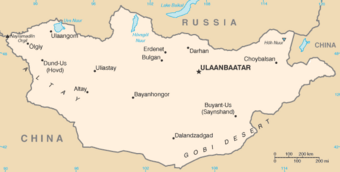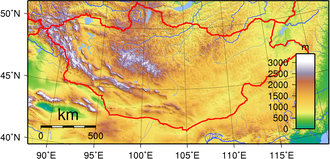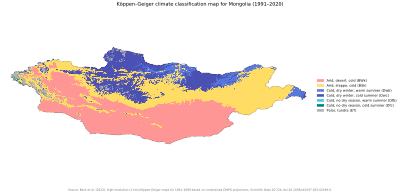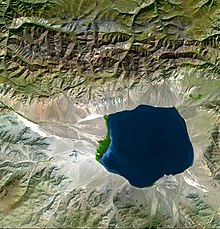Geography of Mongolia
 Map showing the major cities and the neighbouring countries of Mongolia | |
| Continent | Asia |
|---|---|
| Region | East Asia |
| Coordinates | 46°0′N105°0′E/ 46.000°N 105.000°E |
| Area | Ranked 18 |
| • Total | 1,564,116[1]km2(603,909 sq mi) |
| • Land | 99.3% |
| • Water | 0.7% |
| Borders | Russia:3,485 kilometres (2,165 mi) China:4,676 kilometres (2,906 mi) |
| Highest point | Khüiten Peak 4,374 m (14,350 ft) |
| Lowest point | Hoh Nuur 560 m (1,840 ft) |
| Longest river | Orkhon River 1,124 kilometres (698 mi) |
| Largest lake | Uvs Lakeby area: 3,350 km2(1,290 sq mi) Khövsgöl Nuurby volume: 480.7 km3(115.3 cu mi) |
| Climate | Desert; continental |
| Terrain | Vast semidesert and desert plains, grassy steppe, mountains in west and southwest |
| Natural resources | Oil, coal, copper, molybdenum, tungsten, phosphates, tin, nickel, zinc, fluorspar, gold, silver, iron |
| Natural hazards | Dust storms; grassland and forest fires; drought |
| Environmental issues | Limited natural freshwater; the burning of soft coal for power; poor enforcement of environmental laws; severe air pollution in Ulaanbaatar; deforestation,overgrazing,soil erosion; desertification and poor mining practise |
Mongoliais alandlocked countryinEast Asia,located betweenChinaandRussia.The terrain is one of mountains and rollingplateaus,with a high degree of relief.[2]The total land area ofMongoliais 1,564,116 square kilometres.[3]Overall, the land slopes from the highAltai Mountainsof the west and the north to plains and depressions in the east and the south.[2]TheKhüiten Peakin extreme western Mongolia on the Chinese border is the highest point (4,374 m (14,350 ft)).[2]The lowest point is at 560 m (1,840 ft), is theHoh Nuuror lake Huh.[1]The country has an average elevation of 1,580 m (5,180 ft).[2]
The landscape includes one of Asia's largest freshwater lakes (Lake Khövsgöl), many salt lakes, marshes, sand dunes, rolling grasslands, alpine forests, and permanent mountain glaciers.[2]Northern and western Mongolia are seismically active zones, with frequent earthquakes and many hot springs and extinct volcanoes.[2]The nation's closest point to any ocean is approximately 645 kilometres (401 mi) from the country's easternmost tip, borderingNorth ChinatoJinzhouinLiaoning province,China along the coastline of theBohai Sea.
Mountain regions
[edit]
Mongolia has four major mountain ranges.[2]The highest is theAltai Mountains,which stretch across the western and the southwestern regions of the country on a northwest-to-southeast axis.[2]The range contains the country's highest peak, the 4,374 m (14,350 ft) highKhüiten Peak.[2]
TheKhangai Mountains,mountains also trending northwest to southeast, occupy much of central and north-central Mongolia.[2]These are older, lower, and more eroded mountains, with many forests and alpine pastures.[2]
TheKhentii Mountains,trending from northeast to southwest for about 400 kilometres (250 mi), occupy central Mongolia's north eastern part. The northern parts are covered intaiga,while the southern parts are filled with drysteppe.The range forms the watershed between theArctic Ocean(viaLake Baikal) and thePacific Oceanbasins. Rivers originating in the range include theOnon,Kherlen,MenzaandTuul.[4]These mountains also house the capital ofUlaanbaatar.
TheKhövsgöl Mountainsoccupy the north of the country. It trends from north to south and generally has a lot of steep peaks. Young mountain range with Alpine characteristics, high gradient, with narrow cliffs.[4]
Much of eastern Mongolia is occupied by a plain, and the lowest area is a southwest-to-northeast trending depression that reaches from theGobi Desertregion in the south to the eastern frontier.[2]
Rivers and lakes
[edit]
Some of Mongolia's waterways drain to the oceans, but many finish atEndorheic basinsin the deserts and the depressions of Inner Asia.[5]Rivers are most extensively developed in the north, and the country's major river system is that of theSelenge,which drains viaLake Baikalto theArctic Ocean.[2]Some minor tributaries of Siberia'sYenisei River,which also flows to the Arctic Ocean, rise in the mountains of northwestern Mongolia.[2]In northeastern Mongolia theOnon Riverdrains into thePacific Oceanthrough theShilka Riverin Russia and theAmur(Heilong Jiang) rivers,[2]forming thetenth longestriver system in the world.

Many rivers of western Mongolia end at lakes in theCentral Asian Internal Drainage Basin,most often in theGreat Lakes Depression,or atHulun Lake,Ulaan LakeorUlungur Lake.[6]The few streams of southern Mongolia do not reach the sea but run into lakes or deserts.[2]
Mongolia's largest lake by area,Uvs Lakeis in the Great Lakes Depression. Mongolia's largest lake by volume of water,Lake Khövsgöl,drains via the Selenge river to the Arctic Ocean. One of the most easterly lakes of Mongolia,Hoh Nuur,at an elevation of 557 metres, is the lowest point in the country.[7]In total, the lakes and rivers of Mongolia cover 10,560 square kilometres, or 0.67% of the country.[1]
Climate
[edit]Overview
[edit]
Mongolia has a high elevation, with a cold and dry climate.[2]It has an extreme continental climate with long, very cold winters and short summers, during which most precipitation falls.[2]The country averages 257 cloudless days a year, and it is usually at the center of a region of high atmospheric pressure.[2]Precipitation is highest in the north, which averages 200 to 350 millimeters (7.9 to 13.8 in) per year, and lowest in the south, which receives 100 to 200 millimeters (3.9 to 7.9 in).[2]The extreme south is theGobi Desert,some regions of which receive no precipitation at all in most years.[2]The name Gobi is a Mongol word meaning desert, depression, salt marsh, or steppe, but which usually refers to a category of arid rangeland with insufficient vegetation to support marmots but with enough to support camels.[2]Mongols distinguish Gobi from desert proper, although the distinction is not always apparent to outsiders unfamiliar with the Mongolian landscape.[2]Gobi rangelands are fragile and are easily destroyed by overgrazing, which results in expansion of the true desert, a stony waste where not evenBactrian camelscan survive.[2]
Average temperatures over most of the country are below freezing from November through March and are above freezing in April and October.[2]Winter nights can drop to −40 °C (−40.0 °F) in most years.[8]Summer extremes reach as high as 38 °C (100.4 °F) in the southern Gobi region and 33 °C (91.4 °F) inUlaanbaatar.[2]Most of Mongolia is covered bydiscontinuous permafrost(grading to continuous at high altitudes),[citation needed]which makes construction, road building, and mining difficult.[2]All rivers and freshwater lakes freeze over in the winter, and smaller streams commonly freeze to the bottom.[2]Ulaanbaatar lies at 1,351 meters (4,432 ft) above sea level in the valley of theTuul River.[2]Located in the relatively well-watered north, it receives an annual average of 310 millimetres (12.2 in) of precipitation, almost all of which falls in July and in August.[2]Ulaanbaatar has an average annual temperature of −2.9 °C (26.8 °F) and a frost-free period extending on the average from mid-May to late August.[2]
Mongolia's weather is characterized by extreme variability and short-term unpredictability in the summer, and the multiyear averages conceal wide variations in precipitation, dates of frosts, and occurrences of blizzards and spring dust storms.[2]Such weather poses severe challenges to human and livestock survival.[2]Official statistics list less than 1% of the country as arable, 8 to 10% as forest, and the rest as pasture or desert.[2]Grain, mostly wheat, is grown in the valleys of the Selenge river system in the north, but yields fluctuate widely and unpredictably as a result of the amount and the timing of rain and the dates of killing frosts.[2]
| Climate data for Ulaanbaatar city weather station (WMO identifier: 44292) | |||||||||||||
|---|---|---|---|---|---|---|---|---|---|---|---|---|---|
| Month | Jan | Feb | Mar | Apr | May | Jun | Jul | Aug | Sep | Oct | Nov | Dec | Year |
| Record high °C (°F) | −2.6 (27.3) |
11.3 (52.3) |
17.8 (64.0) |
28.0 (82.4) |
33.5 (92.3) |
38.3 (100.9) |
39.0 (102.2) |
34.9 (94.8) |
31.5 (88.7) |
22.5 (72.5) |
13.0 (55.4) |
6.1 (43.0) |
39.0 (102.2) |
| Mean daily maximum °C (°F) | −15.6 (3.9) |
−9.6 (14.7) |
−0.7 (30.7) |
9.7 (49.5) |
17.8 (64.0) |
22.5 (72.5) |
24.5 (76.1) |
22.3 (72.1) |
16.7 (62.1) |
7.6 (45.7) |
−5.0 (23.0) |
−13.5 (7.7) |
6.4 (43.5) |
| Daily mean °C (°F) | −21.6 (−6.9) |
−16.6 (2.1) |
−7.4 (18.7) |
2.0 (35.6) |
10.1 (50.2) |
15.7 (60.3) |
18.2 (64.8) |
16.0 (60.8) |
9.6 (49.3) |
0.5 (32.9) |
−11.9 (10.6) |
−19.0 (−2.2) |
−0.4 (31.3) |
| Mean daily minimum °C (°F) | −25.9 (−14.6) |
−22.2 (−8.0) |
−13.6 (7.5) |
−4.3 (24.3) |
3.3 (37.9) |
9.6 (49.3) |
12.9 (55.2) |
10.6 (51.1) |
3.6 (38.5) |
−4.8 (23.4) |
−15.7 (3.7) |
−22.9 (−9.2) |
−5.8 (21.6) |
| Record low °C (°F) | −42.2 (−44.0) |
−42.2 (−44.0) |
−38.9 (−38.0) |
−26.1 (−15.0) |
−16.1 (3.0) |
−3.9 (25.0) |
−0.2 (31.6) |
−2.2 (28.0) |
−13.4 (7.9) |
−22.0 (−7.6) |
−37.0 (−34.6) |
−37.8 (−36.0) |
−42.2 (−44.0) |
| Averageprecipitationmm (inches) | 2 (0.1) |
3 (0.1) |
4 (0.2) |
10 (0.4) |
21 (0.8) |
46 (1.8) |
64 (2.5) |
70 (2.8) |
27 (1.1) |
10 (0.4) |
6 (0.2) |
4 (0.2) |
267 (10.5) |
| Average rainy days | 0.1 | 0.03 | 0.2 | 2 | 7 | 13 | 16 | 14 | 8 | 2 | 0.2 | 0.2 | 63 |
| Average snowy days | 8 | 7 | 7 | 7 | 3 | 0.3 | 0.2 | 0.4 | 2 | 6 | 8 | 10 | 59 |
| Averagerelative humidity(%) | 78 | 73 | 61 | 48 | 46 | 54 | 60 | 63 | 59 | 60 | 71 | 78 | 62 |
| Mean monthlysunshine hours | 179.1 | 204.8 | 265.2 | 262.5 | 299.3 | 269.0 | 249.3 | 258.3 | 245.7 | 227.5 | 177.4 | 156.4 | 2,794.5 |
| Source 1: Pogoda.ru.net[9] | |||||||||||||
| Source 2:NOAA(sun, 1961–1990)[10] | |||||||||||||
| Climate data for Choibalsan | |||||||||||||
|---|---|---|---|---|---|---|---|---|---|---|---|---|---|
| Month | Jan | Feb | Mar | Apr | May | Jun | Jul | Aug | Sep | Oct | Nov | Dec | Year |
| Record high °C (°F) | 1.3 (34.3) |
8.4 (47.1) |
21.4 (70.5) |
29.5 (85.1) |
36.8 (98.2) |
41.2 (106.2) |
39.1 (102.4) |
38.3 (100.9) |
31.6 (88.9) |
28.0 (82.4) |
15.2 (59.4) |
3.5 (38.3) |
41.2 (106.2) |
| Mean daily maximum °C (°F) | −14.4 (6.1) |
−10.7 (12.7) |
−0.5 (31.1) |
10.5 (50.9) |
19.0 (66.2) |
24.9 (76.8) |
26.6 (79.9) |
24.4 (75.9) |
18.0 (64.4) |
8.8 (47.8) |
−3.4 (25.9) |
−11.8 (10.8) |
7.6 (45.7) |
| Daily mean °C (°F) | −20.5 (−4.9) |
−17.7 (0.1) |
−7.8 (18.0) |
2.6 (36.7) |
11.3 (52.3) |
17.6 (63.7) |
19.8 (67.6) |
17.9 (64.2) |
10.6 (51.1) |
1.5 (34.7) |
−9.8 (14.4) |
−17.6 (0.3) |
0.7 (33.2) |
| Mean daily minimum °C (°F) | −25.5 (−13.9) |
−23.9 (−11.0) |
−14.8 (5.4) |
−4.1 (24.6) |
3.8 (38.8) |
10.8 (51.4) |
14.4 (57.9) |
12.1 (53.8) |
4.9 (40.8) |
−4.2 (24.4) |
−15.2 (4.6) |
−22.7 (−8.9) |
−5.4 (22.3) |
| Record low °C (°F) | −41.6 (−42.9) |
−38.3 (−36.9) |
−36.6 (−33.9) |
−20.3 (−4.5) |
−8.7 (16.3) |
0.5 (32.9) |
4.4 (39.9) |
2.1 (35.8) |
−6.0 (21.2) |
−20.3 (−4.5) |
−29.9 (−21.8) |
−36.4 (−33.5) |
−41.6 (−42.9) |
| Averageprecipitationmm (inches) | 1.6 (0.06) |
1.9 (0.07) |
2.9 (0.11) |
6.3 (0.25) |
14.4 (0.57) |
39.0 (1.54) |
57.4 (2.26) |
43.3 (1.70) |
27.2 (1.07) |
7.7 (0.30) |
3.3 (0.13) |
2.6 (0.10) |
207.6 (8.16) |
| Average precipitation days(≥ 1.0 mm) | 0.6 | 1.0 | 0.7 | 1.6 | 3.2 | 5.7 | 8.7 | 8.1 | 4.6 | 1.6 | 1.1 | 0.9 | 37.8 |
| Mean monthlysunshine hours | 198.5 | 212.0 | 266.1 | 264.0 | 294.9 | 307.3 | 297.9 | 287.1 | 258.2 | 239.2 | 199.5 | 177.6 | 3,002.3 |
| Source: NOAA (1961-1990)[11] | |||||||||||||
Zud
[edit]
Although winters are generally cold and clear, and livestock can survive, under various weather conditions livestock are unable to graze and die in large numbers.[2]A winter in which this occurs is known as azud;causes include blizzards, drought, extreme cold, and freezing rain.[12]Such losses of livestock, which are an inevitable and, in a sense, normal consequence of the climate, have made it difficult for planned increases in livestock numbers to be achieved.[2]
Seasonal blizzards
[edit]
Severe blizzards can occur in the region. The winters of 1970–1971, 2000–2001, 2008–2009 and 2009–2010 were particularly harsh, featuring extremely severe zuds.
Theblizzardsof December 2011 blocked many roads, and killed 16,000 livestock and 10 people.[13][14]TheMongolian State Emergency Commissionsaid it was the coldest winter in thirty years and, like the preceding harsh summerdrought,[13][14]could have been the result ofglobal warming.TheUnited Nationsprovided major aid due to the high level of damage caused.[15]
In thesnowstormsbetween the 8 and 28 May 2008, 21 people were killed and 100 others went missing in seven provinces in eastern Mongolia.[16][17][18]The toll finally reached at least 52 people and 200,000 livestock by the end of June.[19]Most of the victims were herders who froze to death along with their livestock.[16]It was the worstcold snapsince the founding of the modern state in 1922.
Snowstorms in December 2009 – February 2010 also killed 8,000,000 livestock and 60 people.[20]
Climate change
[edit]
Climate changehas threatened the ways of life for traditional pastoralist herders, as it is a driving factor of disruptivedzuds and gans,also known as extreme climatic events ornatural disasters.Winter storms,droughtperiods, and extreme temperatures have become more frequent.[21]Leading up to 2000, there were approximately 20 extreme events per year, but since 2000, this number has doubled to 40 events per year. Between 2008 and 2010 Mongolia experienced 153 extreme events, most of which being strong winds, storms, and floods from run-off.[22]
Since 1940, the average year wise temperature in Mongolia has increased by at least 1.8 °C. This temperature shift is deemed responsible for an increase ingrasslandaridity,and as a result, a lowering of the production of biomass. TheGobi desertis expected to creep northward at approximately 6–7 km / year, which is expected to further limitpastureland.[21]
Another result of these meteorological shifts is expected to be precipitation that occurs in concentrated bursts and cannot be absorbed by the soil. The rising temperatures will alsomelthigh mountainglaciers,degradepermafrost,and will cause more transpiration from plants.[21]
Mongolia, specifically forUlaanbaatar'svulnerable neighborhoods, is receiving help from theEuropean Investment Bankin converting neighborhoods vulnerable to climate change into more climate-resilient and ecological districts. Plans call for constructing 10,000 houses in 20environmentally friendlyneighborhoods with easy access to businesses and nearby employment.[23][24]Women-led families in Mongolia will have preferential access to this new green affordable housing, and 40% of workplaces and at least 40% of green mortgage loans will go to women-led companies.[23][24]
In April 2024, Bloomberg reported thatclimate changeis significantly impacting Mongolia, particularly through the increasing frequency of "dzud"events, with six occurrences in the last decade causing the loss of around 5.9 million animals, or 9% of the country's livestock. The nation has experienced a temperature rise of 2.5°C over the past 80 years, exacerbating environmental degradation and economic challenges. Despitelivestock productionaccounting for just 10% of GDP, it supports over 80% of the rural populace. The latest dzud event affected almost the entire country, resulting in a 7% increase in Mongolia's consumer price index and higher fodder costs, which also impact the vitalcashmere industry.International and national initiatives are focusing on sustainable practices and renewable energy to mitigate these climate change effects.[25]

Ecoregions
[edit]
- Altai montane forest and forest steppe
- Khangai Mountains conifer forests
- Selenge-Orkhon forest steppe
- Sayan montane conifer forests
- Trans-Baikal conifer forests
- Daurian forest steppe
- Mongolian-Manchurian grassland
- Altai alpine meadow and tundra
- Khangai Mountains alpine meadow
- Sayan alpine meadows and tundra
- Alashan Plateau semi-desert
- Eastern Gobi desert steppe
- Gobi desert
- Gobi Lakes Valley desert steppe
- Great Lakes Basin desert steppe
- Junggar Basin semi-desert
Resources and land use
[edit]Land use:
arable land:
9.10%
permanent crops:
0%
other:
99.61% (2011)
Irrigated land: 843 km² (2011)
Total renewable water resources: 34.8 km3(2011)
See also
[edit]References
[edit]- ^abc
 This article incorporatespublic domain materialfrom"Mongolia".The World Factbook(2024 ed.).CIA.2022.(Archived 2022 edition.)
This article incorporatespublic domain materialfrom"Mongolia".The World Factbook(2024 ed.).CIA.2022.(Archived 2022 edition.)
- ^abcdefghijklmnopqrstuvwxyzaaabacadaeafagahaiajakDeGlopper, Donald R. (1991). "The Society and Its Environment". In Worden, Robert L.; Savada, Andrea Matles (eds.).Mongolia: a country study.Washington, D.C.:Federal Research Division,Library of Congress.LCCN90006289.OCLC622910663.[page needed]
- ^"Population by sex, annual rate of population change, surface area and density"(PDF).United Nations Statistics Division.2020.Archived(PDF)from the original on February 12, 2022.RetrievedFebruary 12,2022.
- ^abE, Batchuluun; G, Ymchaa; Ts, Ser-Od; Ts, Tsendsuren; L, Odmandah (2019).Газарзүй VIII(2 ed.). Ulaanbaatar, Mongolia. p. 34.ISBN978-99978-61-09-2.Archived fromthe originalon 2021-02-25.Retrieved2020-06-20.
{{cite book}}:CS1 maint: location missing publisher (link) - ^Grizard, Pierre; Schmitt, Jean-Michel; Goblet, Patrick (February 2019). "Hydrogeology of an arid endorheic basin (Tsagaan Els, Dornogobi, Mongolia): field data and conceptualization, three-dimensional groundwater modeling, and water budget".Hydrogeology Journal.27(1): 145–160.Bibcode:2019HydJ...27..145G.doi:10.1007/s10040-018-1868-1.ProQuest2110121076.
- ^"Rivers and Water".Mongolia Travel Guide.Archived fromthe originalon 27 November 2016.Retrieved26 November2016.
- ^Central Asian Review, Volume 15.Central Asian Research Centre. 1967.Retrieved26 November2016.
- ^"Climate of the World: Mongolia | weatheronline.co.uk".weatheronline.co.uk.Archivedfrom the original on 2019-12-03.Retrieved2020-10-30.
- ^КЛИМАТ УЛАН-БАТОРА(in Russian). Pogoda.ru.net.Archivedfrom the original on 4 July 2014.Retrieved4 January2015.
- ^"Ulaanbaatar Climate Normals 1961–1990".National Oceanic and Atmospheric Administration. Archived fromthe originalon 2017-10-10.Retrieved4 January2015.
- ^"Choibalsan Climate Normals 1961-1990".National Oceanic and Atmospheric Administration.RetrievedJanuary 13,2013.
- ^Leary, Neil; Conde, Cecilia; Kulkarni, Jyoti; Pulhin, Juan; Nyong, Anthony (2008).Climate Change and Vulnerability.Earthscan.ISBN978-1-84977-080-4.
- ^ab"Breaking News, Latest News and Videos".CNN.2014-02-19. Archived fromthe originalon 2013-03-24.Retrieved2020-10-30.
- ^ab"Asian Disaster Reduction Center ( ADRC )".adrc.asia.Archivedfrom the original on 2021-05-04.Retrieved2020-10-30.
- ^[1][permanent dead link]
- ^ab"21 dead in Mongolian snowstorms".Retrieved2010-01-13.[dead link]
- ^"Heavy snowstorm kills 21 in Mongolia - People's Daily Online".en.people.cn.Archived fromthe originalon 2012-10-11.Retrieved2020-10-30.
- ^"Snowstorm kills 21 in Mongolia - Thaindian News".Archived fromthe originalon 2016-03-03.Retrieved2010-01-13.
- ^"At least 52 dead in Mongolia snowstorm - Channel NewsAsia".Archived fromthe originalon 2012-12-02.Retrieved2010-01-16.
- ^"The UB Post-Leading English News - Snow Storm Casualties".Archived fromthe originalon 2010-01-18.Retrieved2010-01-16.
- ^abcTaylor, Marcus (2015).The Political Ecology of Climate Change Adaptation: Livelihoods, Agrarian Change and the Conflicts of Development.Routledge. pp. Chapter 8.
- ^"REPORT ON STATE OF THE ENVIRONMENT OF MONGOLIA, 2008-2010"(PDF).Ministry of Nature, Environment and Tourism.Archived fromthe original(PDF)on 2020-05-08.Retrieved2016-11-03.
- ^ab"ADB to Help Ulaanbaatar Transform its Ger Areas into Eco-Districts".Asian Development Bank.2018-08-28.Retrieved2022-10-24.
- ^abadbheadhoncho (2018-08-24)."Ulaanbaatar Green Affordable Housing and Resilient Urban Renewal Sector Project".Asian Development Bank.Retrieved2022-10-24.
- ^"Mongolia's Livestock Are Being Killed by Winter Climate Disasters".Bloomberg.2024-04-06.Retrieved2024-04-06.
External links
[edit]- (in Mongolian)Administration of Land Affairs, Geodesy and Cartography
- (in English and Mongolian)Official government site – Institute of Meteorology and Hydrology
- (in English and Mongolian)Official government site – Mineral Resources Authority
- (in English and Mongolian)Official government site – Water Agency of MongoliaArchived2020-02-09 at theWayback Machine
- Limnological Catalogue of Mongolian Lakes[permanent dead link]
- GEOLOGY OF THE KHARKHIRAA UUL, MONGOLIAN ALTAI

